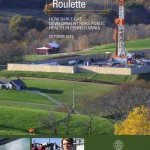by Nadia Steinzor ’04 MS (Also see Nadia and her organization, Earthworks, featured in Huffington Post.)
 New York remains at a decision crossroads when it comes to developing its shale gas resources, widely known as fracking. Thanks to growing opposition and the state’s environmental review process, New York hasn’t rushed forward with a quest for energy that nationwide is putting air and water quality at risk. The most recent delay comes as the Department of Environmental Conservation considers study of a critical but overlooked issue: public health impacts.
New York remains at a decision crossroads when it comes to developing its shale gas resources, widely known as fracking. Thanks to growing opposition and the state’s environmental review process, New York hasn’t rushed forward with a quest for energy that nationwide is putting air and water quality at risk. The most recent delay comes as the Department of Environmental Conservation considers study of a critical but overlooked issue: public health impacts.
When Earthworks’ Oil & Gas Accountability Project (OGAP) started working in the
Marcellus Shale region, we heard about people who said they got sick after gas drilling
began. About children getting nosebleeds every night and adults in the prime of life who
were constantly fatigued. Rural residents surrounded by chemical odors. Tap water that
foams and dizzy spells after showering. Unfortunately, we’d heard similar stories before in
Texas, Wyoming, Colorado, and Louisiana.
Last week, OGAP released Gas Patch Roulette, a report that adds to a limited body of
information on the health impacts of shale gas development. Data from more than 100
health surveys and more than 30 air and water samples in Pennsylvania show that
contaminants associated with oil and gas development are present in air and water in
many communities where gas development is occurring and where many residents have
developed health symptoms that they did not have before. Both trends point to a strong
association with gas development.
Specifically, we found that rates of commonly reported symptoms (such as throat irritation, headaches, and sinus problems) generally increase the closer people live to gas facilities and that children often experience symptoms atypical in the young, such as forgetfulness and joint pain. To a high degree, symptoms reported at particular locations matched the scientifically established effects of exposure to chemicals that were detected at those locations.
Gas Patch Roulette also discusses the wide gaps in science, testing, and policy that leave
many questions about the health and environmental impacts of gas and oil development
unanswered. For example, safety standards don’t even exist for many chemicals associated with oil and gas development, or for continual exposure to multiple contaminants—making assertions of safety by the gas industry and some policymakers specious at best.
With all this in mind, we concluded that by permitting widespread gas development
without fully understanding its impacts—and using that lack of knowledge to justify
regulatory inaction—Pennsylvania and other states are risking the public’s health.
Preliminary research and personal experiences have often been dismissed, only to be
proven accurate years or decades later, for example with Agent Orange during the Vietnam War; toxic chemicals at Love Canal, benzene in drinking water at a North Carolina military base; and exposure to airborne contaminants on 9-11. Earthworks hopes that history will not repeat itself when it comes to oil and gas development across the United States, including in New York. Gas Patch Roulette lays out the steps that must be taken without delay to safeguard public health—a bet with high stakes that is very worth making.
Gas Patch Roulette and additional information on the process and impacts of oil and gas
development are available at http://health.earthworksaction.org
 Nadia Steinzor is a 2004 graduate of the Bard Center for Environmental Policy and currently works as the Eastern Program Coordinator for Earthworks’ Oil & Gas Accountability Project.
Nadia Steinzor is a 2004 graduate of the Bard Center for Environmental Policy and currently works as the Eastern Program Coordinator for Earthworks’ Oil & Gas Accountability Project.
